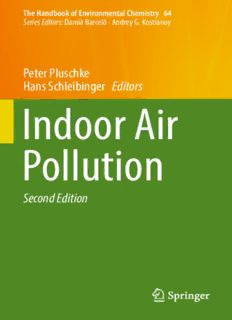
Indoor Air Pollution PDF
Preview Indoor Air Pollution
The Handbook of Environmental Chemistry 64 Series Editors: Damià Barceló · Andrey G. Kostianoy Peter Pluschke Hans Schleibinger E ditors Indoor Air Pollution Second Edition The Handbook of Environmental Chemistry Founded by Otto Hutzinger (cid:1) Editors-in-Chief: Damia Barcelo´ (cid:129) Andrey G. Kostianoy Volume 64 Advisory Board: Jacob de Boer, Philippe Garrigues, Ji-Dong Gu, Kevin C. Jones, Thomas P. Knepper, Alice Newton, Donald L. Sparks Moreinformationaboutthisseriesathttp://www.springer.com/series/698 Indoor Air Pollution Volume Editors: Peter Pluschke (cid:1) Hans Schleibinger With contributions by G.A. Ayoko (cid:1) K. Balakrishnan (cid:1) C-G. Bornehag (cid:1) X. Fan (cid:1) S. Ghosh (cid:1) J. Hao (cid:1) C. He (cid:1) P. Johnson (cid:1) L. Morawska (cid:1) K. Mukhopadhyay (cid:1) P. Ramaswamy (cid:1) T. Salthammer (cid:1) S. Sankar (cid:1) V. Thanasekaraan (cid:1) G. Thangavel (cid:1) H. Wang (cid:1) T. Zhu Second Edition Editors Peter Pluschke HansSchleibinger CityofNuremberg NationalResearchCouncilCanada DepartmentofEnvironmentand Ottawa,ON,Canada Health Nürnberg,Germany ISSN1867-979X ISSN1616-864X (electronic) TheHandbookofEnvironmentalChemistry ISBN978-3-662-56063-1 ISBN978-3-662-56065-5 (eBook) https://doi.org/10.1007/978-3-662-56065-5 LibraryofCongressControlNumber:2017961617 ©Springer-VerlagGmbHGermany2018 Thisworkissubjecttocopyright.AllrightsarereservedbythePublisher,whetherthewholeorpartof the material is concerned, specifically the rights of translation, reprinting, reuse of illustrations, recitation, broadcasting, reproduction on microfilms or in any other physical way, and transmission or information storage and retrieval, electronic adaptation, computer software, or by similar or dissimilarmethodologynowknownorhereafterdeveloped. The use of general descriptive names, registered names, trademarks, service marks, etc. in this publicationdoesnotimply,evenintheabsenceofaspecificstatement,thatsuchnamesareexempt fromtherelevantprotectivelawsandregulationsandthereforefreeforgeneraluse. Thepublisher,theauthorsandtheeditorsaresafetoassumethattheadviceandinformationinthis book are believed to be true and accurate at the date of publication. Neither the publisher nor the authors or the editors give a warranty, express or implied, with respect to the material contained hereinor for anyerrors oromissionsthat may havebeenmade. Thepublisher remainsneutralwith regardtojurisdictionalclaimsinpublishedmapsandinstitutionalaffiliations. Printedonacid-freepaper ThisSpringerimprintispublishedbySpringerNature TheregisteredcompanyisSpringer-VerlagGmbH,DE Theregisteredcompanyaddressis:HeidelbergerPlatz3,14197Berlin,Germany Editors-in-Chief Prof. Dr. Dami(cid:1)a Barcelo´ Prof. Dr. Andrey G. Kostianoy DepartmentofEnvironmentalChemistry P.P.ShirshovInstituteofOceanology IDAEA-CSIC RussianAcademyofSciences C/JordiGirona18–26 36,NakhimovskyPr. 08034Barcelona,Spain 117997Moscow,Russia and [email protected] CatalanInstituteforWaterResearch(ICRA) H20Building ScientificandTechnologicalParkofthe UniversityofGirona EmiliGrahit,101 17003Girona,Spain [email protected] Advisory Board Prof. Dr. Jacob de Boer IVM, VrijeUniversiteit Amsterdam,The Netherlands Prof. Dr. Philippe Garrigues Universityof Bordeaux,France Prof. Dr. Ji-Dong Gu The Universityof HongKong,China Prof. Dr. Kevin C. Jones Universityof Lancaster, UnitedKingdom Prof. Dr. Thomas P. Knepper Universityof AppliedScience, Fresenius,Idstein, Germany Prof. Dr. Alice Newton Universityof Algarve, Faro,Portugal Prof. Dr. Donald L. Sparks Plant and SoilSciences, Universityof Delaware, USA The Handbook of Environmental Chemistry Also Available Electronically The Handbook of Environmental Chemistry is included in Springer’s eBook packageEarthandEnvironmentalScience. Ifalibrarydoes notoptfor thewhole package,thebookseriesmaybeboughtonasubscriptionbasis. ForallcustomerswhohaveastandingordertotheprintversionofTheHandbook ofEnvironmentalChemistry,weofferfreeaccesstotheelectronicvolumesofthe SeriespublishedinthecurrentyearviaSpringerLink.Ifyoudonothaveaccess,you canstillviewthetableofcontentsofeachvolumeandtheabstractofeacharticleon SpringerLink(www.springerlink.com/content/110354/). Youwillfindinformationaboutthe – EditorialBoard – AimsandScope – InstructionsforAuthors – SampleContribution atspringer.com(www.springer.com/series/698). Allfiguressubmittedincolorarepublishedinfullcolorintheelectronicversionon SpringerLink. Aims and Scope Since 1980, The Handbook of Environmental Chemistry has provided sound and solid knowledge about environmental topics from a chemical perspective. Presenting a wide spectrum of viewpoints and approaches, the series now covers topics such as local and global changes of natural environment and climate; anthropogenicimpactontheenvironment;water,airandsoilpollution;remediation and waste characterization; environmental contaminants; biogeochemistry; geo- ecology;chemicalreactionsandprocesses;chemicalandbiologicaltransformations as well as physical transport of chemicals in the environment; or environmental modeling. A particular focus of the series lies on methodological advances in environmentalanalyticalchemistry. vii Series Preface Withremarkablevision,Prof. OttoHutzingerinitiatedTheHandbook ofEnviron- mentalChemistry in1980andbecamethe foundingEditor-in-Chief.Atthattime, environmental chemistry was an emerging field, aiming at a complete description of the Earth’s environment, encompassing the physical, chemical, biological, and geologicaltransformationsofchemicalsubstancesoccurringonalocalaswellasa global scale. Environmental chemistry was intended to provide an account of the impact of man’s activities on the natural environment by describing observed changes. Whileaconsiderableamountofknowledgehasbeenaccumulatedoverthelast three decades, as reflected in the more than 70 volumes of The Handbook of Environmental Chemistry, there are still many scientific and policy challenges ahead due to the complexity and interdisciplinary nature of the field. The series will therefore continue to provide compilations of current knowledge. Contribu- tions are written by leading experts with practical experience in their fields. The Handbook of Environmental Chemistry grows with the increases in our scientific understanding, and provides a valuable source not only for scientists but also for environmental managers and decision-makers. Today, the series covers a broad rangeofenvironmentaltopicsfromachemicalperspective,includingmethodolog- icaladvancesinenvironmentalanalyticalchemistry. Inrecentyears,therehasbeenagrowingtendencytoincludesubjectmatterof societal relevance in the broad view of environmental chemistry. Topics include life cycle analysis, environmental management, sustainable development, and socio-economic, legal and even political problems, among others. While these topics are of great importance for the development and acceptance of The Hand- bookofEnvironmentalChemistry,thepublisherandEditors-in-Chiefhavedecided tokeepthehandbookessentiallyasourceofinformationon“hardsciences”witha particular emphasis on chemistry, but also covering biology, geology, hydrology andengineeringasappliedtoenvironmentalsciences. Thevolumesoftheseriesarewrittenatanadvancedlevel,addressingtheneeds ofbothresearchersandgraduatestudents,aswellasofpeopleoutsidethefieldof ix x SeriesPreface “pure” chemistry, including those in industry, business, government, research establishments, and public interest groups. It would be very satisfying to see these volumes used as a basis for graduate courses in environmental chemistry. Withitshighstandardsofscientificqualityandclarity,TheHandbookofEnviron- mental Chemistry provides a solid basis from which scientists can share their knowledge on the different aspects of environmental problems, presenting a wide spectrumofviewpointsandapproaches. TheHandbookofEnvironmentalChemistryisavailablebothinprintandonline via www.springerlink.com/content/110354/. Articles are published online as soon as they have been approved for publication. Authors, Volume Editors and Editorsin-Chief are rewarded by the broad acceptance of The Handbook of Envi- ronmentalChemistrybythescientificcommunity,fromwhomsuggestionsfornew topicstotheEditors-in-Chiefarealwaysverywelcome. Dami(cid:1)aBarcelo´ AndreyG.Kostianoy Editors-in-Chief Preface Intheyear1751JohnArbuthnotpublished“AnEssayconcerningtheEffectsofAir on Human Bodies” [1] and gave a comprehensive review of the scientific state of theartofhistime.Hesummarizedhisknowledgeandhisfindingsinanumberof “PracticalAphorisms”suchas“PrivateHousesoughttobeperflatedonceaDay,by opening Doors and Windows, to blow off the Animal Steams” and a second example “Houses for the sake of Warmth fenc’d from Wind, and where the Carpenters Work is so nice as to exclude all outward Air, are not the most wholsom.” His thoughts are still valid and his treaty is still valuable – not in all details. Building technologies and practices have changed much and Indoor Science becameaverybroad,inter-disciplinaryfieldofknowledge. Goingthroughtheagendaofinternationalconferencesonindoorairandrecent publications,therearestillanumberoftopics,whichhavebeendiscussedalready in the eighteenth and nineteenth centuries, such as moisture and dampness [2], mouldandbacteria[3],andbadodoursandcarbondioxide[4]. Relatively early research on hygienic conditions in urban dwellings and estab- lishments by Pettenkofer and others in the eighteenth and nineteenth centuries covered some of still today relevant topics in indoor air quality. Pettenkofer developed some basic principles. From a hygienic point of view he analysed the indoor living conditions and came to the conclusion that science could contribute significantlyinimprovingeverydaylifebydefiningrulesforindoorenvironmental qualityandhealth. He revealed [5–8] that human emissions and activities must be taken into considerationand – Hedevelopedaconceptforchamberstudiesofindooremissionsources[6].He summarized:“substanceswhichpassofffromtheskinandlungsrequireasclose aninvestigationasthosethatareeliminatedbytheurine.Hithertonomethodhas been devised, or apparatus constructed, adequate to the conditions of such an inquiry. ... The present state of physiology requires conditions of inquiry in whichamancanbreatheandmovefreelywithoutanyapparatusattachedtohis xi
Description: